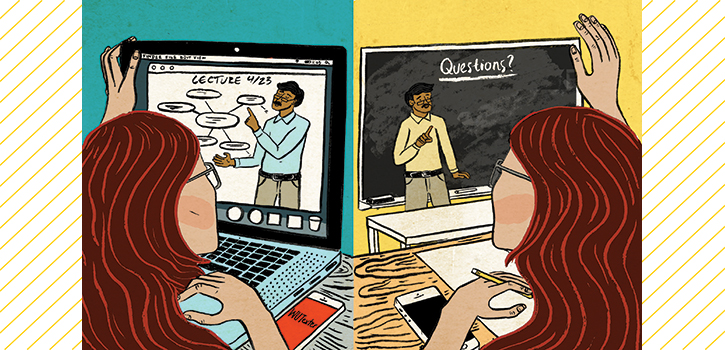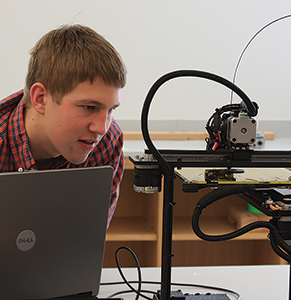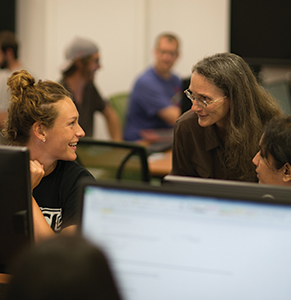Upside-down learning

For the past few years, higher education institutions have been changing the traditional lecture format in classes to improve the quality of education and appeal to different learning styles. The “flipped classroom” approach has students watch a videotaped lecture prior to class then discuss it during class time. In engineering, this includes working on problems or homework during the classroom time with the instructor available to answer questions. While this approach puts the onus of learning on the individual student, it allows for more interaction among students and a window into how they are learning and understanding the material.
The art of teaching has remained the same for millennia: a teacher stands in front of the class and lectures, while students sit and listen, then show what they have learned through exams and papers. But today's students, who have grown up with the Internet, email, mobile phones and multitasking, are not as responsive to this method as previous generations. This has led faculty at the School of Engineering & Applied Science to develop innovative teaching methods to keep students engaged and successful in the classroom.
Blackboards have been replaced with white boards or SMART Boards, lecture times have been shortened while in-class activities have increased, and interactive teaching tools have been integrated to gauge students' understanding of the concepts without them having to raise their hands.
In a traditional classroom format, students are focused on taking notes in preparation for what might be on an exam rather than absorbing what the instructor is saying. In large lecture classes, asking questions during a lecture may not be possible. If students don't understand the concepts, it is their responsibility to follow up with the instructor or teaching assistant or fellow classmates.
To improve the quality of education and appeal to different learning styles, many universities and colleges have been implementing the "flipped classroom" approach, in which students watch a videotaped lecture prior to class, then discuss it during class time. In engineering, this includes working on problems or homework during the classroom time, with the instructor available to answer questions.
Washington University Engineering faculty have implemented a variety of flipped-classroom-style approaches that have resulted in a better understanding of the course material by students and better grades as a result. While this approach puts the onus of learning on the individual student and may create more work for the instructor, it allows for more interaction among students and a window into how they are learning and understanding the material.
Since the flipped classroom approach is only about seven years old, hard data showing its benefits is limited. However, some researchers say that informing students about concepts and procedures before completing problems in class undermines the type of learning needed for understanding, according to an editorial in Science. In addition, students may not attend class if they can view the lecture online, thereby missing the value of the activities done during class time, or may come to class unprepared with the background to complete the activities.
Click, click, click
As you might expect, faculty members in Computer Science & Engineering are making the most of the newest technology to keep students engaged.
Roger Chamberlain, DSc, associate department chair and professor, has been using different class formats in several courses, including Computer Science I and II, Introduction to Digital Logic and Computer Design, and Introduction to Systems Software, which cover freshmen, sophomores and juniors. Chamberlain began the experiment through the six-year CPATH-T grant, funded by the National Science Foundation in 2007 and led by former professor Kenneth Goldman, PhD.
Chamberlain tried a variety of approaches to active learning, including a flipped classroom approach in Introduction to Systems Software, in which students were assigned to watch recorded lectures ahead of class. Chamberlain began the class with questions about the lectures, then allowed students to work on problems during class in small groups.
"In a large class, I don't want students to feel intimidated about asking questions, so this lowers the threshold."
– Ron Cytron, PhD
"At the end of the semester, we compared project and test scores with those of the course two years' prior, which was taught in the traditional method, and we saw a good standard deviation improvement in the new format," Chamberlain says.
Chamberlain has also incorporated a new technology into his classes called the i>clicker, a hand-held device similar to a remote control that allows students to answer an instructor's multiple choice questions electronically. The clickers are particularly useful in large classes, Chamberlain says.
"It's a way to get students to tell me what they are understanding and not understanding without them having to raise their hands and speak in front of everyone," he says. "If a lot of students give the wrong answer, then I know where the problem is, and we talk about it."
Chamberlain's course is included in a variety of projects, funded by a grant from the Association of American Universities (AAU), in which active-learning strategies are integrated into introductory science, technology, engineering and mathematics (STEM) courses. Students may check out an i>clicker from the John M. Olin Library. The device has five buttons that can correspond to multiple-choice answers A-E or 1-5. While responses are anonymous, each device has a serial number, so instructors can give participation credit to students who answer questions.
Bryn Lutes, PhD, assistant director, academic services, in The Teaching Center, said about 1,400 clickers are being used this semester across the STEM fields.
"Instructors are really interested in assessing how their students are doing with the content before they give an exam," Lutes says.
Ron Cytron, PhD, professor of computer science & engineering, took the idea a step further and developed his own interactive system using students' own cell phones and Twitter. Cytron and a former student, Ben Murray, and current student Hunter LaTourette developed the WUTexter app, which allows students to use Twitter to send direct messages to the app. Their answers and any other questions they have appear on Cytron's computer screen.
Cytron has been using WUTexter in Computer Science I, a freshman course with about 200 students, with good feedback.
"What I observed is that near the beginning of the class, students use that as a way to ask me simple questions," Cytron says.

Interactive learning
Engineering students often ask for more hands-on learning experiences amid courses with heavy theory and problem sets. Donald Elbert, PhD, associate professor of biomedical engineering, implemented hands-on learning while teaching Design of Artificial Organs in Fall 2013, in which students had to design a left ventricular assist device (LVAD).
Previously, students created a computer model of the device using computer-aided design and computational fluid dynamics. However, last fall, Elbert worked with Patricia Widder, lecturer in biomedical engineering, to allow students to create a model of their design using a 3-D printer. Then, each student could connect his or her 3-D-printed LVAD to a motor and pump water to simulate blood flow. That allowed them to see if the devices were working and what needed to be redesigned.
"The students really crave the hands-on experience and to have new techniques to put on their resumes," Elbert says.
SMART Boards & iTunes
Pratim Biswas, PhD, the Lucy & Stanley Lopata Professor and chair of the Department of Energy, Environmental & Chemical Engineering, used a hybrid flipped classroom approach in his Fall 2013 graduate-level course, Aerosol Science & Technology. The course uses a lot of equations, and students often wanted to go back to the lecture to see how the equations were derived and used. Previously, the lectures were videotaped for students to review after class via Blackboard. However, the videos showed only the chalkboard and did not show what Biswas was doing in real time. This year, Biswas and his teaching assistant, Tandeep Chadha, used SMART Board technology, which records the writing and long derivations. The students could later watch the recording with the ability to pause, rewind or slow the replay and observe detailed steps of the derivations. At Chadha's suggestion, the lectures were made available on iTunes U, which allows educators to design complete courses with audio, video and other content and distribute them through the iTunes U app, which is free and available to anyone.
A SMART Board is a large, interactive, touch-response computer monitor that shows the professor's presentation, but also allows the instructor to write on it like a chalkboard.
Biswas and Chadha worked with Ted Chaffin and Steven Vance of Washington University Libraries Instructional Support Services department inside the Arc Technology Center at the Olin Library, which has SMART Boards available for use. The library's SMART Board was modified to actively capture Biswas' voice and presentation slides, while also recording his live lecture and demonstrations of equations.
Biswas got an unexpected response to the iTunes content: Without any publicity, about 800 users downloaded the content. In addition, five engineers working for a company in Chicago found the content and audited the class through the publicly available lectures.
Chadha; Yang Wang, the other teaching assistant; and Biswas worked with Gina Frey, PhD, executive director of the Teaching Center, to do some experiments. They pre-recorded their class on a SMART Board, made it available to students before class and used a flipped approach for discussion. In another test, they showed the pre-recorded lecture during class, with and without Biswas present. After students and Frey evaluated these models, the instructors received valuable feedback that would enable improved learning of content that was difficult to understand. For their efforts, Chadha and Wang were selected by the students to receive the 2014 Department of Energy, Environmental & Chemical Engineering Teaching Assistant Award.

In-class help
In Mechanical Engineering & Materials Science (MEMS), several faculty who have changed the format of their classes have seen positive results in students.
Shaun Sellers, lecturer in MEMS, teaches Engineering Mechanics II. He introduced a flipped-classroom approach a few years ago when he realized students weren't responding well to the straight lecture format.
Sellers tried a few different blends of lecture and in-class problem solving. Ultimately, the students told him they wanted a 15-minute lecture at the beginning of the class to summarize the material they had read before class, then to use the remainder of the class time to apply those ideas to problems.
"The response I got was really positive," Sellers says. "Attendance was nearly perfect, and students had a really positive attitude in class. The lecture was immediately relevant to what they were doing, so they paid attention and asked questions."
Sellers says the students worked together well in and outside of class.
"When the class was over, about half of them stayed in it to continue working on problems," he says. "Next semester, I've scheduled the room for another hour after class so the room is available if students want to continue working. I'll also stay in the room to answer questions."
Kenna Middleton, a junior majoring in mechanical engineering and a student in Sellers' course, says she felt like she learned more from the class because of the format.
"I have found that in an interactive class setting, I am able to pay attention better. I feel more free to ask questions, and students learn to help each other."
— Kenna Middleton
"Because of the 'team effort' feel, students would collaborate on the same problem and share ideas back and forth," Middleton says. "By doing this, I was able to delve deeper into why I was doing a certain method versus another. This allowed me to learn the overall concepts deeper than I would have with a teacher lecturing at me. Also, because of this class setting, I was able to move freely about the classroom, which allowed me to concentrate better."
Mary Malast, DSc, adjunct instructor, has successfully integrated a flipped classroom approach in the Engineering Economy course in the University of Missouri–St. Louis/WUSTL Joint Undergraduate Engineering Program. The course meets one evening a week for three hours.
"What I found was going over the lecture material didn't help them a lot in class because they are already tired when they come into the classroom," she says. "I changed the format so a big part of their assignment is to go through the resources provided with the textbook — PowerPoint slides, video lecture and interactive online tools — then come to class with questions."
Malast splits the class period in half, with half of the time spent in the classroom and the other half in the computer lab. While students work in small groups, she can work with each group.
The approach has been successful: Malast says no student got lower than a C in the course last fall.
Next fall, Malast plans to hold the class entirely in the computer lab to better accommodate the needs of the students in the Joint Program.
"These are place-bound students who work during the day," she says. "The flipped classroom helps them a lot."
STEM initiative
In 2013, Washington University was one of eight AAV member campuses selected to serve as project sites for an initiative to improve the quality of undergraduate education in the STEM fields. The School of Engineering & Applied Science, the College of Arts & Sciences, The Teaching Center and the Center for Integrative Research on Cognition, Learning, and Education (CIRCLE) are leading the charge for Washington University, which is using the $500,000 in seed money from the three-year grant to explore and implement active-learning techniques.
Engineering Virtual Studio, required for biomedical engineering students, is a four-semester, one-credit, pass-fail course in which students work with peer mentors, professionals working in the field, the WUSTL Career Center and the Writing Center. The first group of students to complete the program will finish at the end of Spring 2014.
Washington University proposed to incorporate active learning into lower-level STEM courses and identify active-learning best practices.
Kurt Thoroughman, PhD, associate professor and associate chair for undergraduate studies in biomedical engineering, is one of the four Washington University investigators on the AAU STEM Initiative. Thoroughman, who also is director of undergraduate studies for the School of Engineering & Applied Science, has initiated Engineering Virtual Studio, a pilot intervention program for freshmen and sophomore Engineering students designed to connect their foundational courses with "the real world."
"Freshmen and sophomore students are asked to focus on individual foundational courses and are told that it will all make sense later when they are juniors and seniors," Thoroughman says. "I want to make the experience one where integrative thought and attention to how the individual student understands how they fit into these bigger pictures begin with day one of the curriculum and persists through their first four semesters rather than offput until the junior and senior years."
Back to Engineering Momentum